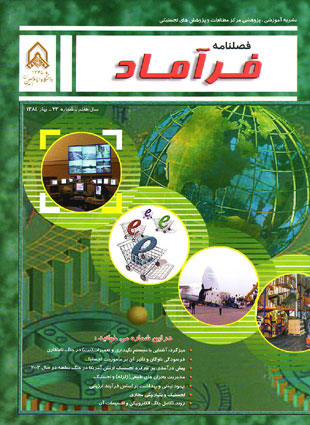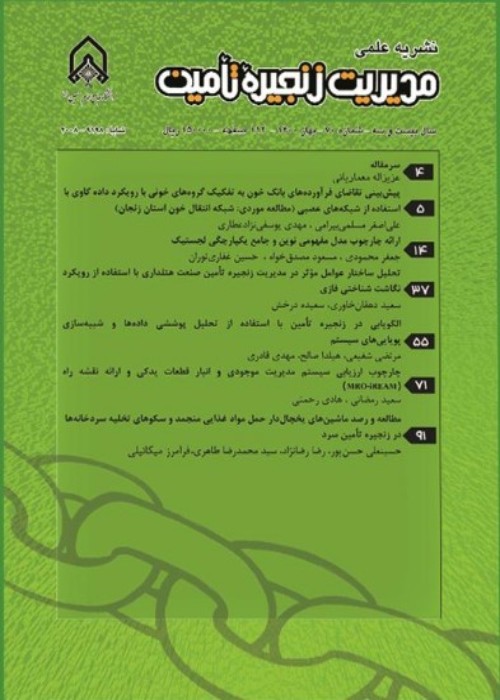فهرست مطالب

فصلنامه مدیریت زنجیره تامین
پیاپی 23 (بهار 1384)
- 96 صفحه،
- تاریخ انتشار: 1384/07/10
- تعداد عناوین: 12
-
صفحه 2
-
صفحه 4
در زمان گذشته هنگامی که ارتش و مردم کشوری نمی توانستند از غلبه دشمن و اشغال سرزمینشان جلوگیری کنند و یا آن را از اشغال دشمن آزاد سازند به شیوه هایی روی می آوردند که امروز به جنگ نامتقارن می گویند. در حال حاضر جنگ نامتقارن رویکردی است که همه از آن بهره می جویند، کشورهای قوی برای تحمیل خواسته خود به کشورهای ضعیف و منکوب کردن آنها و متقابلا کشورهای ضعیف، به عنوان عامل بازدارنده و، با توجه به پیشرفت های شگرف در فناوری نظامی و تنوع ابداعات در شیوه های مبارزاتی، می توان گفت که محیط جنگ های آینده عمدتا نامتقارن هستند...
-
صفحه 20
لازمه داشتن لجستیکی کارآمد، بهره گیری از سیستمهای حمل و نقلی مطمئن برای انجام ماموریتهای جابجایی نفرات، کالاها و تجهیزات است. بخشی از ناوگان مورد نیاز از امکانات سازمان های خصوصی و دولتی تامین می گردد و برخی از آنها باید در سازمان ترابری سپاه تعبیه گردد. امکانات بخش دوم اصولا با گذشت زمان فرسوده می گردد و با فرض اجرای برنامه های جامع برای نگهداری این تجهیزات، با آمدن فن آوری های جدید و افزایش عمر ناوگان، عدم جایگزینی تجهیزات جدید باعث کاهش توان حمل و نقل سازمان لجستی خواهد شد...
-
صفحه 37
در شماره قبل ضمن بیان کلیاتی پیرامون مطالعات تطبیقی، عملکرد آماد و پشتیبانی در حوادث زلزله رودبار و بم تبیین و مورد ارزیابی قرار گرفت. در این شماره ابتدا به بررسی مدیریت بحران کشور پرداخته شده و قوانین موجود در خصوص وظایف عوامل امدادی خصوصا سپاه پاسداران در مراحل مختلف بحران گردیده است. د رادامه، مدیریت بحران و چرخه آن در مراحل مختلف مورد بررسی قرار گرفته و چگونگی برنامه ریزی مقابه با بحران و نکات قابل توجه و مهم در مراحل مختلف آن به تفضیل مورد اشاره قرار می گیرد.
-
صفحه 59
-
صفحه 70
در جنگهای پیشرفته امروزی، ارتشی موفق است که از سیستمهای الکترونیکی کمال استفاده را ببرد. با پیشرفت سلاح ها و سیستمهای الکترونیکی شاخه ای در علوم ایجاد شده است که بدون اغراق در معادلات نظامی دنیا جزء پارامترهای تعیین کننده است. اگرچه علم الکترونیک از همان آغاز در جنگ افزارهای نظامی مورد استفاده قرار می گرفت اما امروز شاخه ای خاص با نام جنگ الکترونیکی بوجود آمده است. منظور از جنگ الکترونیکی بهره برداری از طیف الکترومغناطیسی منتشر شده توسط دشمن برای پی بردن به اهداف، توانایی ها و در نهایت استفاده از نقاط ضعف برای ضربه زدن به سیستمهای تسلیحاتی و مخابراتی دشمن و همزمان استفاده از همان طیف برای دستیابی به مقاصد خود می باشد...
-
صفحه 85
-
صفحه 94
-
صفحه 95
-
Page 20
Having efficient logistics requires the use of reliable transportation systems to carry out missions to transport people, goods and equipment. Part of the required fleet is provided by the facilities of private and public organizations, and some of them must be installed in the IRGC transportation organization. The facilities of the second part will be worn out over time, and assuming that comprehensive programs are implemented to maintain this equipment with the advent of new technologies, and increase fleet life, failure to replace new equipment will reduce the transport capacity of the logistics organization. In this article, while defining car wear and tear and designing the dimensions of this problem, we express the need to modernize the fleet
-
Page 29
The recent war between the United States and Iraq is crucial. First, it introduces us to modern military thought around the world and provides a powerful tool for upgrading its military heart and related techniques. This incident caused different views to be expressed and an excuse to express opinions and research. Second, the narrative-analytical study of each military event is part of the "indirect experience" that any military or those interested in the science and art of war need to improve their skills. Military knowledge and the art of war have been taught over the years in formal and informal discourse and education, but perhaps several generations of people in the country have failed to put it to the test in real life, and this is the fundamental difference between this science and other disciplines. This article tries to cover some of the situation and some logistical functions of the US military in the form of a battle scene.
-
Page 37
In the previous issue, while generalizing about comparative studies, the performance of readiness and support in Rudbar and Bam earthquake events was explained and evaluated. In this issue, first, the crisis management of the country is examined and the existing laws regarding the duties of the relief agents, especially the Revolutionary Guards, in different stages of the crisis are stated. In the following, crisis management and its cycle are examined in different stages and how to deal with crisis and significant points in its various stages are discussed in detail.
-
Page 52
To implement continuous improvement, it is necessary to start from the evaluation, which will be possible to achieve in the form of a process from concern to improvement. This assessment should be implemented in such a way that the key issues of the units are identified and effective executive solutions are defined for the desired issues. Each organization evaluates its safety and health concerns to determine its strengths and weaknesses and then the most key ones. They choose and improve issues. Also to implement this process, the main steps of which include: 1- Concern 2. Problem solving 3- Problem refinement 4- Definition of implementation of improvement areas (process improvement includes major improvements, problem solving improvements, partial improvements and improvement and improvement of design) Monitoring and follow-up of implementation of improvement areas, audit executive teams And inspection is used
Keywords: Assessment, Self Assessment, Audit, Monitoring, Continual Improvement, Objective Evidence -
Page 70
n today's advanced wars, a successful army is able to make full use of electronic systems. With the advancement of weapons and electronic systems, a branch of science has been created that is one of the determining parameters without exaggerating the world's military equations. Although electronics has been used in military weapons from the beginning, there is now a special branch called electronic warfare. Electronic warfare refers to the exploitation of the enemy's electromagnetic spectrum to detect targets, capabilities, and ultimately the use of vulnerabilities to strike at the enemy's weapons and telecommunications systems while simultaneously using the same spectrum to achieve its goals. The role of electronic systems in command and control networks and sets has doubled the importance and value of electronic warfare. Given the importance of the issue, it is appropriate for commanders and experts to become familiar with the evolution of electronic warfare and the classification of electronic warfare systems. In this article, reports, articles and various books on the evolution of electronic warfare are extracted and then, according to the latest materials provided in e-war, classification for its systems is presented.


